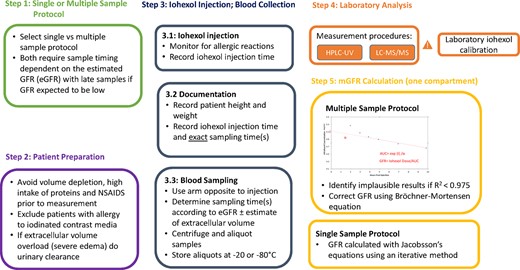-
PDF
- Split View
-
Views
-
Cite
Cite
Natalie Ebert, Elke Schaeffner, Jesse C Seegmiller, Marco van Londen, Arend Bökenkamp, Etienne Cavalier, Pierre Delanaye, Laurence Derain-Dubourg, Bjørn O Eriksen, Runólfur Pálsson, Tariq Shafi, Christine A White, #2422 Iohexol plasma clearance measurement protocol standardization—a consensus of the European Kidney Function Consortium, Nephrology Dialysis Transplantation, Volume 39, Issue Supplement_1, May 2024, gfae069–0547–2422, https://doi.org/10.1093/ndt/gfae069.547
Close - Share Icon Share
Abstract
International consensus supports the development of standardized protocols for measured glomerular filtration rate (mGFR) to facilitate the adoption of mGFR determination in both clinical and research settings.
The European Kidney Function Consortium (EKFC) convened an international group of mGFR experts. The working group performed an extensive literature search to inform the development of recommendations for mGFR determination using one-compartment plasma clearance models and iohexol as the exogenous filtration marker. Iohexol was selected as it is non-radio labeled, inexpensive, widely available, and can be assayed at a central laboratory. Other commonly used non-radio labeled tracers have been (inulin) or are soon to be (iothalamate) discontinued. A plasma clearance model was selected as it requires no timed urine collections. A one-compartment model was preferred to a two compartment model as it requires fewer samples. The resulting recommendations were based on published evidence complemented by expert opinion.
Recommendations include practical advice for patients and health professionals, preparation, administration and safety aspects of iohexol, laboratory analysis, blood sample collection and sample timing for both multiple and single sample protocols, description of the mGFR mathematical calculations as well as implementation strategies (Fig.). EKFC will provide materials such as patient information sheets, standard operating procedures, a study protocol template, and support for mGFR calculation.
Members of the EKFC have evaluated the evidence and formulated recommendations that include all aspects of iohexol plasma clearance measurement using a one compartment model.
*Author list on behalf of the European Kidney Function Consortium (EKFC).

- renal function
- blood tests
- drug clearance
- glomerular filtration rate
- filtration
- health personnel
- inulin
- iohexol
- mathematics
- plasma
- radio communications
- safety
- european continental ancestry group
- urine specimen collection
- iothalamate
- compartment models
- expert opinion
- consensus
- standard operating procedure
- implementation science





Comments